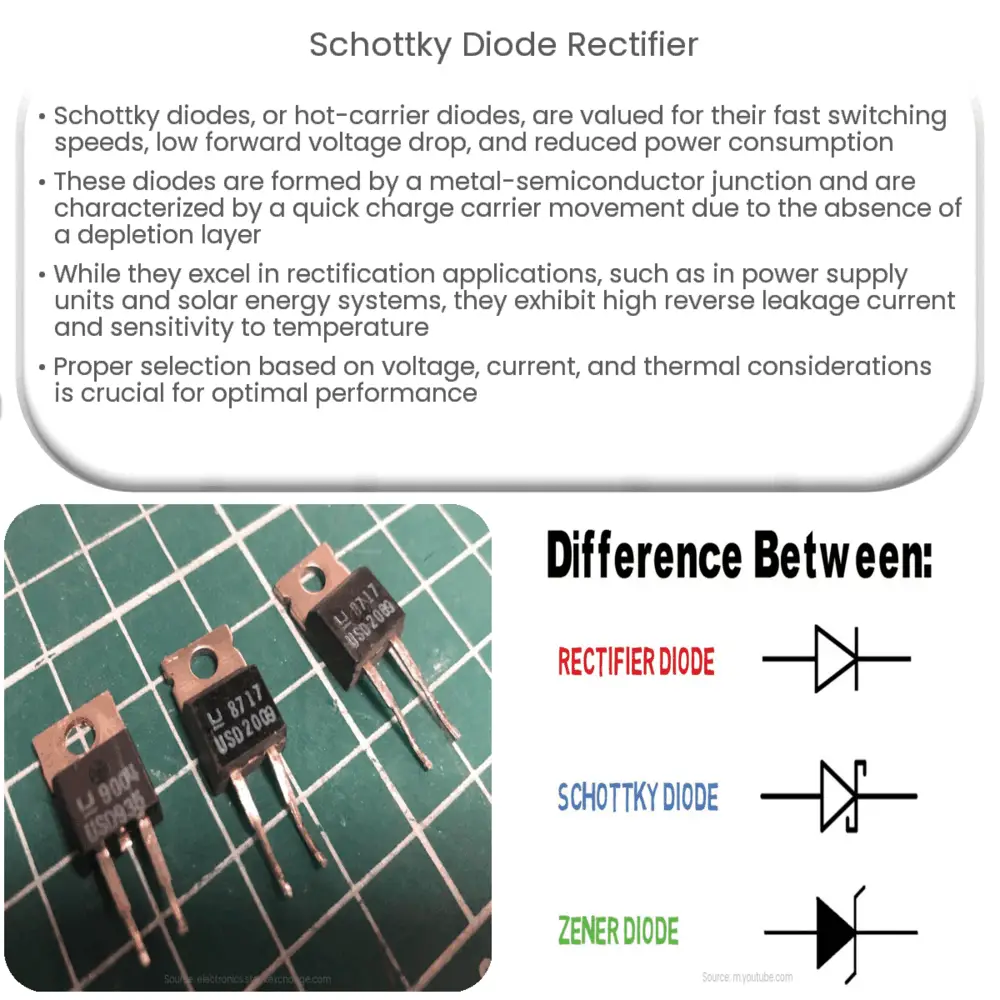Schottky diode rectifiers are semiconductor devices known for their fast switching speeds, low voltage drop, and applications in power conversion and high-frequency circuits.

Schottky Diode Rectifier: Principles and Applications
Introduction
Schottky diodes, also known as Schottky barrier diodes or hot-carrier diodes, are semiconductor devices widely used in various electronic applications due to their fast switching speeds, low forward voltage drop, and low power consumption. This article aims to provide an in-depth understanding of the principles, characteristics, and applications of Schottky diode rectifiers.
Principles and Characteristics of Schottky Diodes
Schottky diodes are formed by creating a metal-semiconductor junction, typically using metals such as gold, platinum, or tungsten on an n-type semiconductor material like silicon or gallium arsenide. The metal-semiconductor junction creates a Schottky barrier, which is responsible for the unique electrical properties of these diodes.
The primary characteristics of Schottky diodes include a low forward voltage drop (typically between 0.15 and 0.45 volts) and fast switching speeds. These features are due to the absence of a depletion layer in the metal-semiconductor junction, allowing for rapid charge carrier movement. Schottky diodes also exhibit low reverse recovery time, which is the time required for the diode to switch from forward conducting to reverse blocking state.
However, Schottky diodes have a few limitations, such as a relatively high reverse leakage current compared to conventional p-n junction diodes. This high leakage current is due to the low barrier height of the Schottky junction, allowing for increased thermionic emission of charge carriers. Furthermore, Schottky diodes are sensitive to temperature variations, which may affect their performance.
Rectification Using Schottky Diodes
Rectification is the process of converting alternating current (AC) to direct current (DC) using diodes. Schottky diodes, with their fast switching speeds and low forward voltage drop, are particularly suited for rectification applications. Two common types of rectifier circuits using Schottky diodes are half-wave and full-wave rectifiers.
In a half-wave rectifier, a single Schottky diode is used to allow only the positive half-cycle of the input AC voltage to pass through, while blocking the negative half-cycle. This results in a pulsating DC output with a frequency equal to the input AC frequency. However, the output waveform contains gaps, which may not be suitable for certain applications.
Full-wave rectifiers, on the other hand, use a bridge configuration of four Schottky diodes to convert both the positive and negative half-cycles of the input AC voltage into a continuous DC output. This configuration provides a smoother DC output, making it more suitable for applications requiring a stable power supply.
Applications of Schottky Diode Rectifiers
Due to their advantageous characteristics, Schottky diode rectifiers find applications in various electronic systems, such as:
- Power supply units: Schottky diode rectifiers are widely used in switch-mode power supplies (SMPS) for their fast switching speeds and low voltage drop, resulting in higher efficiency and reduced heat generation.
- Solar energy systems: Schottky diodes are employed in photovoltaic systems as bypass diodes to prevent reverse current flow and protect solar cells from damage due to partial shading or other issues.
- High-frequency radio frequency (RF) circuits: The fast switching speed of Schottky diodes makes them suitable for use in RF applications, such as mixers, detectors, and modulators in communication systems.
- Automotive electronics: Schottky diode rectifiers are used in voltage regulation and power management systems within vehicles, improving fuel efficiency and overall performance.
- Power inverters: In power inverter circuits, Schottky diodes are used for their low forward voltage drop, resulting in increased efficiency and reduced heat dissipation.
Choosing the Right Schottky Diode Rectifier
When selecting a Schottky diode rectifier for a specific application, several factors must be taken into consideration:
- Voltage rating: The selected Schottky diode must have a reverse voltage rating (VR) higher than the maximum voltage the circuit will experience.
- Current rating: The forward current rating (IF) of the diode should be higher than the maximum current the circuit will draw during operation to prevent damage due to overheating.
- Switching speed: Schottky diodes with faster switching speeds are suitable for high-frequency applications, while slower-switching diodes may be used for lower-frequency applications.
- Thermal management: Since Schottky diodes can generate heat during operation, it is essential to consider the junction temperature (TJ) and thermal resistance (RθJ) to ensure proper heat dissipation and prevent thermal runaway.
Conclusion
Schottky diode rectifiers offer several advantages over conventional p-n junction diodes, such as low forward voltage drop and fast switching speeds, making them ideal for various electronic applications. Despite their limitations, such as high reverse leakage current and sensitivity to temperature variations, Schottky diodes continue to play a significant role in power supply units, solar energy systems, RF circuits, automotive electronics, and power inverters. By carefully considering the voltage and current ratings, switching speed, and thermal management requirements, designers can select the most suitable Schottky diode rectifier for their specific application.

